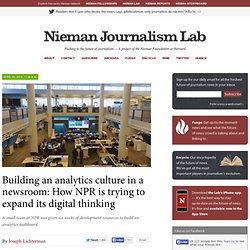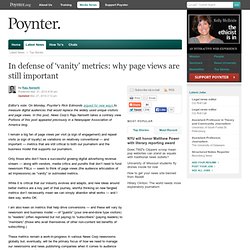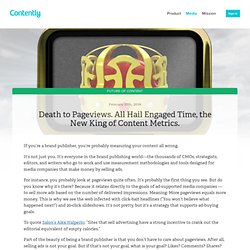

Data decisions: How the Guardian and Forbes built custom analytics platforms. A look at how and why the Guardian and Forbes decided to create their own platforms to measure data about content consumption How does your newsroom monitor analytics?

Perhaps you use a handful of third-party tools, or refer to a larger catalogue of platforms to guide editorial direction. Another option is to 'do it yourself', which is something a number of media outlets have decided to do – albeit in some cases in an additional capacity to third-party tools. In this week's podcast we take a look at how two media outlets built their own platforms to measure the performance of content, in a way that is centred on the specific requirements of their own newsrooms. We visit the Guardian, which started work on its system, now called Ophan, during a hack day, and also look at the Forbes 'statistics engine' now said to be an "integral" part of the newsroom.
We speak to: You can hear future podcasts by signing up to the Journalism.co.uk podcast feed on iTunes. Measuring the news: what are the alternatives to pageviews? Pageviews often dominate the conversation in terms of measuring a website's performance, but is this the correct way to measure a news organisation's online success?

And if no, what alternatives are there? Speaking at the International Journalism Festival in Perugia, these questions were posed by Pier Luca Santoro, a social media editor at La Stampa and founder of Data Hub, to a panel of experts on the issue of metrics. "It's gone to this extreme now where people follow the pageview to the exclusion of everything else," said Gregary Galant, co-founder and chief executive of Saw Horse media. If we're optimising for the link then no wonder we get link baitTony Haile, Chartbeat Pageviews are often taken to advertisers as proof of a campaign's performance but pageviews offer no insight into the quality of content, or the impact it may have had on a reader, said Tony Haile, chief executive of analytics firm Chartbeat. Building an analytics culture in a newsroom: How NPR is trying to expand its digital thinking.
Being a digital staffer at a traditional news organization means doing digital work, sure — but it often also means serving as an evangelist for the web.

That can take a mixture of convincing, cajoling, and showing by example. When Melody Joy Kramer joined NPR as a digital strategist last year, she knew working to shift its culture toward digital, social, and analytics would be a core part of her work. BuzzFeed.com. Poynter. Editor’s note: On Monday, Poynter’s Rick Edmonds argued for new ways to measure digital audiences that would replace the widely used unique visitors and page views.

In this post, News Corp’s Raju Narisetti takes a contrary view. Portions of this post appeared previously in a Newspaper Association of America blog. I remain a big fan of page views per visit (a sign of engagement) and repeat visits (a sign of loyalty) as variations on relatively conventional — and important — metrics that are still critical to both our journalism and the business model that supports our journalism. Only those who don’t have a successful growing digital advertising revenue stream — along with vendors, media critics and pundits that don’t need to fund newsroom P&Ls — seem to think of page views (the audience articulation of ad impressions) as “vanity” or outmoded metrics.
But the news business is in an existential crisis fueled by dramatic shifts in how our audiences engage with our content. Death to Pageviews. All Hail Engaged Time, the New King of Content Metrics. If you’re a brand publisher, you’re probably measuring your content all wrong.

It’s not just you. It’s everyone in the brand publishing world—the thousands of CMOs, strategists, editors, and writers who go to work and use measurement methodologies and tools designed for media companies that make money by selling ads. For instance, you probably look at pageviews quite often. It’s probably the first thing you see. What You Think You Know About the Web Is Wrong. If you’re an average reader, I’ve got your attention for 15 seconds, so here goes: We are getting a lot wrong about the web these days.

We confuse what people have clicked on for what they’ve read. We mistake sharing for reading. We race towards new trends like native advertising without fixing what was wrong with the old ones and make the same mistakes all over again. Not an average reader? Maybe you’ll give me more than 15 seconds then. Here’s where we started to go wrong: In 1994, a former direct mail marketer called Ken McCarthy came up with the clickthrough as the measure of ad performance on the web. However, the click had some unfortunate side effects. In 20 years, everything else about the web has been transformed, but the click remains unchanged, we live on the click web. It’s no longer just your clicks they want, it’s your time and attention. The data gets even more interesting when you dig in a little. The most valuable audience is the one that comes back.